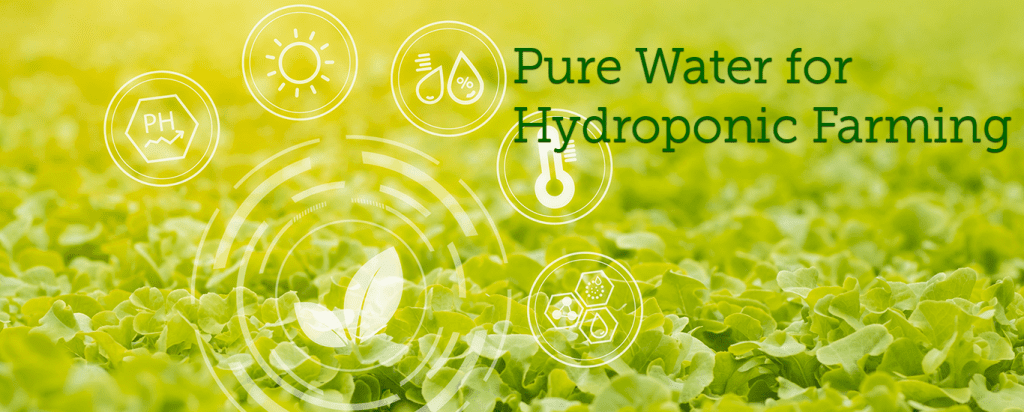
Pure Water brand commercial water distillers are perfect for hydroponic farming. We have commercial water distillation system that can produce hundreds of gallons of distilled water daily and they can also be networked. Our industrial water distillers have a number of great features including leak detection and shut down, automatic drain, built in pump, stainless steel storage tank, and water quality monitor. We have been producing water distillers for over 50 years and are proud to supply units to a variety of industries. We can also help with the installation of our water distillation equipment and provide technical assistance.
Why Water Distillers are better than Reverse Osmosis Systems or Tap Water
Water Distillers provide the grower with a blank slate and clean water devoid of pollutants or bacteria. Tap water can contain many known and unknown contaminants including chlorine, arsenic and uranium to name a few. Reverse Osmosis may filter tap water to a point, but RO systems create a lot of waste water. Conserve water, save money, and get better results with the help of a commercial water distillation system from Pure WaterTM.

Advantages of Using Distilled Water for Hydroponics
The advantages of using distilled water for hydroponic farming are clear. Starting with clean distilled water means that plants are only exposed to the nutrients that have been added to the water by the grower, not chemicals or contaminants, or even minerals found in tap water. This means that contaminants like arsenic or lead that are found in some water supplies or chlorine that is added to treat water will not interfere with plant growth or be taken up by the plant. The pH of distilled water is neutral at 7, and by not having any total dissolved solids, it provides the grower with a clean slate.
Additionally, the minerals found in tap water leave a scale buildup on equipment and even make it unusable or greatly decrease its life span. For example, many hydroponic growers recycle water, so as it goes through the system, having magnesium, gypsum and calcites, otherwise known as hard water, would build up and plug up pipes. Hard water is not a hydroponic grower’s friend.
Benefits of Hydroponic Farming
Thousands of commercial farms and home gardeners are farming hydroponically. The advantage of hydroponics includes being able to grow plants closer together, being able to easily move plants, higher yield, faster growth, and less water consumption because of lower evaporation rates. Some growers have been able to increase productions to 20 times per acre of what traditional farming produces. In greenhouses, because the plants are enclosed and protected, chemicals like herbicides, fungicides, and pesticides are barely necessary. All of this makes hydroponic farming attractive to growers and it is a growing industry.
Disadvantages of Using Soil
Growing with the use of soil can add in more variables. The quality of the soil can affect the final product. Also, knowing exactly which nutrients are already in the soil can be more difficult. Furthermore, it can be hard to know what additional nutrients might be required. Growers may not be able to recycle soil and also pests may be more likely to be present.
Common Crops Grown Hydroponically
Crops that grow well in a hydroponic environment include cucumbers, tomatoes, peppers, lettuce, strawberries, herbs, and many more. There are thousands of growers and the market is growing by 10% a year in the United States. The hydroponics industry is worth 8.1 billion in the United States alone.
Nutrients Required for Hydroponic Farming or Gardening
The following is a list of nutrients needed to grow plants. In addition to these, there are some elements that may also be beneficial like Nickel, Selenium, Silica, and Cobalt, depending on your crop.
- Nitrogen (N)
- Potassium (K)
- Phosphorus (P)
- Calcium (Ca)
- Magnesium (Mg)
- Sulphur (S)
- Iron (Fe)
- Manganese (Mn)
- Copper (Cu)
- Zinc (Zn)
- Molybdate (Mo)
- Boron (B)
- Chlorine (Cl)
Six Types of Hydroponic Systems
There are six types of hydroponic systems: the Wick System, Water Culture System, Ebb and Flow System, Drip System, N.F.T. (Nutrient Film Technique) System and the Aeroponic System. Each of these systems have advantages and disadvantages. Some are easier to set up and some are less expensive, while others are more suited to commercial use. Some growers choose to have backup electricity systems or solar power to make sure pumps do not fail.
The Wick System

The wick system is a basic hydroponic system and doesn’t require any pumps and it is essentially a passive system. The rope, felt or wick is used to bring up water to the plants. It is an easy system that works best for smaller plants. Often coconut coir is used as a growing medium.
The Deep Water Culture System
This system holds the plants’ roots in the water constantly so that they get a constant supply of oxygen and nutrients. This is the easiest type of hydroponic system. Plants are placed in foam boards in net pots and a pump and air stone provide oxygen to the plants. Some disadvantages to the water culture system is that it is not good for larger plants or ones with longer grow times. The advantage is that it is inexpensive and easy to manage.

The Ebb and Flow System
The ebb and flow system is also sometimes known as the flood and drain system. In this system, the tray with plants in a growing medium, is flooded periodically throughout the day, and then drained by gravity. The solution is then oxygenated by a pump and air stone. Growers use this system because it is flexible and efficiently uses water and nutrients. The downside is that if the pump fails, the roots can easily dry out and the grower needs more medium.
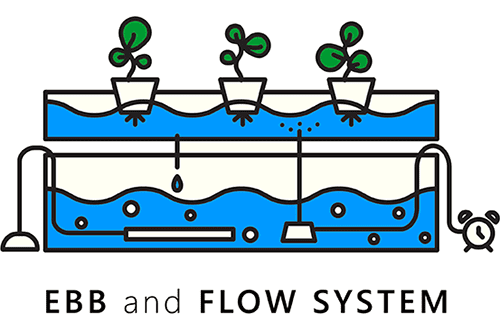
Drip System
Commercial operations often use drip systems. Drip systems are relatively cheap and provide a constant and controllable source of water and nutrients. These systems generally include a reservoir, pump and timers. One downside is that the pH and nutrient levels may be harder to regulate if recirculating a solution.
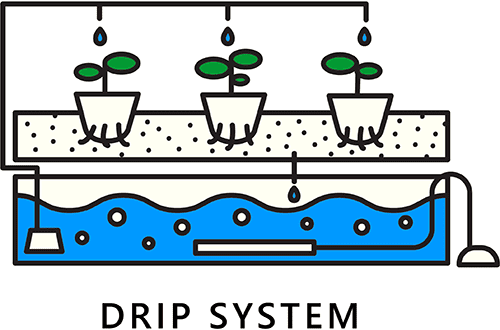
N.F.T. (Nutrient Film Technique) System
NFT systems are popular among commercial growers. Plants are put into a channel with a water and nutrient solution constantly running beneath the roots. Then the solution runs down into a reservoir and is pumped back up through the channel. Plants are not completely submerged and plants are placed in a medium within a net pot so individual plants can be harvested if needed. Some benefits of this system are less waste and minimal growing medium is needed. Some disadvantages include pump failure and overgrown roots.
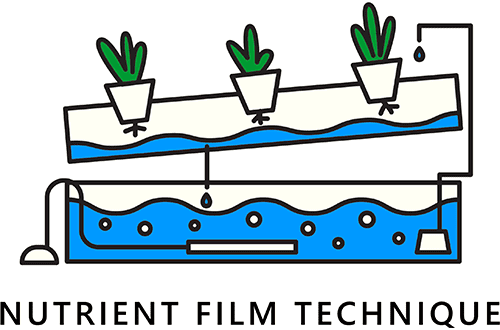
Aeroponic System
Many consider the aeroponic system to be high tech. In this system, roots are exposed to the air and are misted constantly or every few minutes. The system is believed by some to grow plants faster than other systems. It is more expensive to set up, however, and bit more knowledge is required.
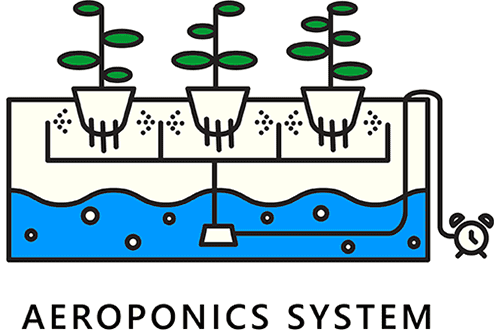
Industries Pure Water Distillers Serve
- Agriculture
- Laboratories
- Restaurants
- Schools
- Apartment Buildings
- Assisted Living Facilities
- Cosmetics Industry
- Hair Salons
- Hospitals
- Dental Clinics
- Coffee / Tea Shops
- Government Institutions (Embassies, Armed Forces)
- Factories
- Food Processing Facilities
- Pharmaceutical
- Printing Companies
- Electronics
- Battery Industry
Sources:
Hydroponics: The power of water to grow food
http://sitn.hms.harvard.edu/flash/2019/hydroponics-the-power-of-water-to-grow-food/
The Future of Farming: Hydroponic Tomatoes
https://www.youtube.com/watch?v=bRyBKWqLzI8
Hydroponics
https://en.wikipedia.org/wiki/Hydroponics
Hydroponic Systems
https://ag.umass.edu/greenhouse-floriculture/fact-sheets/hydroponic-systems
Hydroponics
https://www.nal.usda.gov/afsic/hydroponics
Comparison of Land, Water, and Energy Requirements of Lettuce Grown Using Hydroponic vs. Conventional Agricultural Methods
https://www.ncbi.nlm.nih.gov/pmc/articles/PMC4483736/



